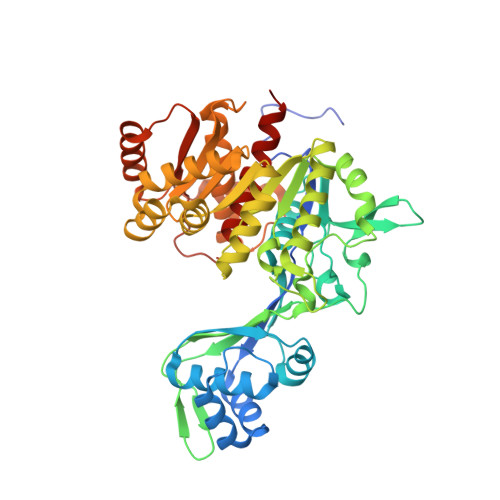ADP-dependent 6-phosphofructokinase from Pyrococcus horikoshii OT3: structure determination and biochemical characterization of PH1645.
Currie, M.A., Merino, F., Skarina, T., Wong, A.H., Singer, A., Brown, G., Savchenko, A., Caniuguir, A., Guixe, V., Yakunin, A.F., Jia, Z.(2009) J Biol Chem 284: 22664-22671
- PubMed: 19553681
- DOI: https://doi.org/10.1074/jbc.M109.012401
- Primary Citation of Related Structures:
1U2X, 3DRW - PubMed Abstract:
Some hyperthermophilic archaea use a modified glycolytic pathway that employs an ADP-dependent glucokinase (ADP-GK) and an ADP-dependent phosphofructokinase (ADP-PFK) or, in the case of Methanococcus jannaschii, a bifunctional ADP-dependent glucophosphofructokinase (ADP-GK/PFK). The crystal structures of three ADP-GKs have been determined. However, there is no structural information available for ADP-PFKs or the ADP-GK/PFK. Here, we present the first crystal structure of an ADP-PFK from Pyrococcus horikoshii OT3 (PhPFK) in both apo- and AMP-bound forms determined to 2.0-A and 1.9-A resolution, respectively, along with biochemical characterization of the enzyme. The overall structure of PhPFK maintains a similar large and small alpha/beta domain structure seen in the ADP-GK structures. A large conformational change accompanies binding of phosphoryl donor, acceptor, or both, in all members of the ribokinase superfamily characterized thus far, which is believed to be critical to enzyme function. Surprisingly, no such conformational change was observed in the AMP-bound PhPFK structure compared with the apo structure. Through comprehensive site-directed mutagenesis of the substrate binding pocket we identified residues that were critical for both substrate recognition and the phosphotransfer reaction. The catalytic residues and many of the substrate binding residues are conserved between PhPFK and ADP-GKs; however, four key residues differ in the sugar-binding pocket, which we have shown determine the sugar-binding specificity. Using these results we were able to engineer a mutant PhPFK that mimics the ADP-GK/PFK and is able to phosphorylate both fructose 6-phosphate and glucose.
Organizational Affiliation:
Department of Biochemistry, Queen's University, Kingston, Ontario K7L 3N6, Canada.
















